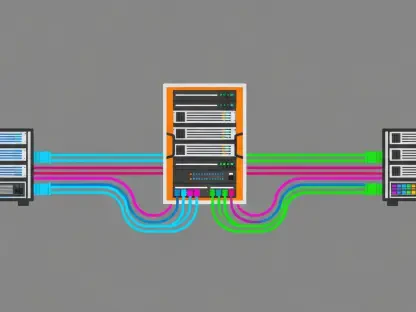In today’s digital ecosystem, IT environments have grown exponentially complex with multicloud architectures and cloud-native applications creating unprecedented challenges for DevOps and security teams, making system management often feel like navigating a labyrinth blindfolded. Traditional tools struggle to keep pace with the sheer volume of data and alerts, leaving teams overwhelmed. This is where causal AI emerges as a transformative force in observability platforms, offering a beacon of clarity by pinpointing root causes rather than merely flagging correlations. Its significance lies in addressing critical blind spots and inefficiencies, making it a cornerstone for organizations striving to maintain reliability and performance. This analysis dives into the rise of causal AI, its practical applications, expert insights, future implications, and essential takeaways for navigating the evolving landscape of IT operations.
The Rise of Causal AI in Observability
Market Growth and Adoption Trends
The shift toward unified observability platforms is gaining momentum, with data indicating that 79% of organizations are either using or planning to adopt such solutions within the next year. This surge reflects a pressing need to consolidate fragmented monitoring approaches that often leave teams juggling an average of 10 different tools, resulting in inefficiencies and delayed responses. The complexity of managing disparate systems has pushed companies to seek streamlined, integrated platforms that provide a holistic view of their IT infrastructure.
Recent industry surveys underscore a growing preference for AI-driven observability, particularly causal AI, due to its precision over traditional correlation-based models. Unlike earlier methods that often misidentify issues through surface-level patterns, causal AI focuses on cause-and-effect relationships, offering more reliable insights. Reports highlight that organizations adopting this technology are better equipped to handle intricate environments, reducing the risk of oversight in critical operations.
Moreover, multicloud adoption continues to accelerate, with 93% of companies leveraging multiple cloud providers to optimize flexibility and innovation. This trend, while beneficial, amplifies the demand for advanced observability solutions capable of bridging visibility gaps across diverse platforms. As businesses expand their cloud footprints, the integration of causal AI becomes indispensable for maintaining control and ensuring seamless performance across hybrid setups.
Real-World Implementations and Success Stories
Across industries, organizations are integrating causal AI into observability platforms to tackle the challenges of multicloud and cloud-native environments with remarkable results. For instance, leading tech firms have deployed this technology to enhance root-cause analysis in Kubernetes clusters, addressing visibility gaps that 76% of technology leaders report as a significant hurdle. By tracing the exact origin of issues, these platforms enable swift resolution and prevent cascading failures.
In microservices architectures, where 89% of IT leaders struggle with monitoring complexities, causal AI has proven instrumental in providing granular insights. A prominent financial services company, for example, utilized a causal AI-powered platform to reduce incident response times by identifying bottlenecks in real-time, resulting in a notable decrease in downtime. Such implementations highlight the technology’s ability to transform chaotic data streams into actionable intelligence.
Additionally, several cutting-edge observability tools have gained traction for their proactive incident management capabilities. These platforms, adopted by major enterprises, use causal AI to anticipate potential disruptions and deliver real-time alerts with contextual depth. Case studies reveal how such tools have bolstered security postures and optimized system performance, demonstrating tangible benefits like improved customer experiences and operational stability.
Expert Perspectives on Causal AI’s Impact
The transformative potential of causal AI in observability has garnered significant attention from industry leaders and DevOps professionals. Many experts emphasize that traditional and correlation-based AI approaches often fall short, with 98% of technology leaders expressing concerns over reliability and inherent biases in generative models. Causal AI, by contrast, offers a more robust framework by focusing on verifiable cause-and-effect dynamics, which is critical for accurate decision-making.
Professionals also point to the technology’s ability to mitigate common pain points such as alert fatigue and sluggish incident response. By filtering out irrelevant noise and zeroing in on the root of problems, causal AI empowers teams to act decisively, reducing the burden of endless notifications. This capability is seen as a game-changer for maintaining operational uptime in high-stakes environments where every second counts.
Looking ahead, experts predict that causal AI will drive greater efficiency and foster collaboration across IT and security teams. Its capacity to provide clear, explainable insights is expected to bridge communication gaps, aligning diverse functions toward common goals. Many foresee cost savings and enhanced scalability as additional benefits, positioning this technology as a strategic asset for long-term organizational success.
Future Outlook for Causal AI in Observability
As observability platforms evolve, causal AI is poised to play an even more central role through advancements in automation and predictive analytics. Future iterations may enable systems to not only detect and resolve issues but also anticipate them with unprecedented accuracy, minimizing disruptions before they escalate. Such capabilities could redefine how businesses manage service reliability in dynamic, distributed setups.
The implications of this trend extend across sectors, promising enhanced security, optimized architectures, and improved performance in multicloud environments. However, challenges like integration hurdles and the need for skilled personnel to oversee AI-driven systems must be addressed. Without proper expertise, organizations risk underutilizing the technology or misinterpreting its outputs, which could hinder expected outcomes.
While positive outcomes such as faster incident resolution and reduced operational costs are anticipated, there is also a cautionary note about over-reliance on AI without human oversight. Balancing automation with critical thinking remains essential to avoid potential pitfalls. Additionally, native data streaming from major cloud providers like AWS, Azure, and Google Cloud, alongside tools like OpenTelemetry, will be crucial for ensuring that observability solutions remain adaptable and future-ready.
Key Takeaways and Call to Action
Causal AI stands as a pivotal innovation in unified observability platforms, addressing the shortcomings of traditional tools in increasingly complex IT landscapes. Its ability to deliver proactive incident management, comprehensive visibility, and precise root-cause analysis marks it as an essential component for tackling modern challenges like multicloud blind spots and alert overload. Organizations prioritizing these qualities are better positioned to maintain resilience amid digital transformation.
Reflecting on the journey, the adoption of causal AI has proven to be a turning point for many enterprises seeking to streamline operations in intricate environments. Its impact on reducing downtime and enhancing decision-making underscores a shift toward smarter, more reliable IT management practices. The insights gained from early implementations offer a blueprint for others to follow.
Looking ahead, organizations are encouraged to evaluate and invest in platforms leveraging causal AI to ensure faster, more informed decision-making. Exploring partnerships with vendors offering robust integration with cloud ecosystems and focusing on building internal expertise have emerged as vital steps. These actions promise to secure long-term operational success and adaptability in an ever-evolving technological landscape.









